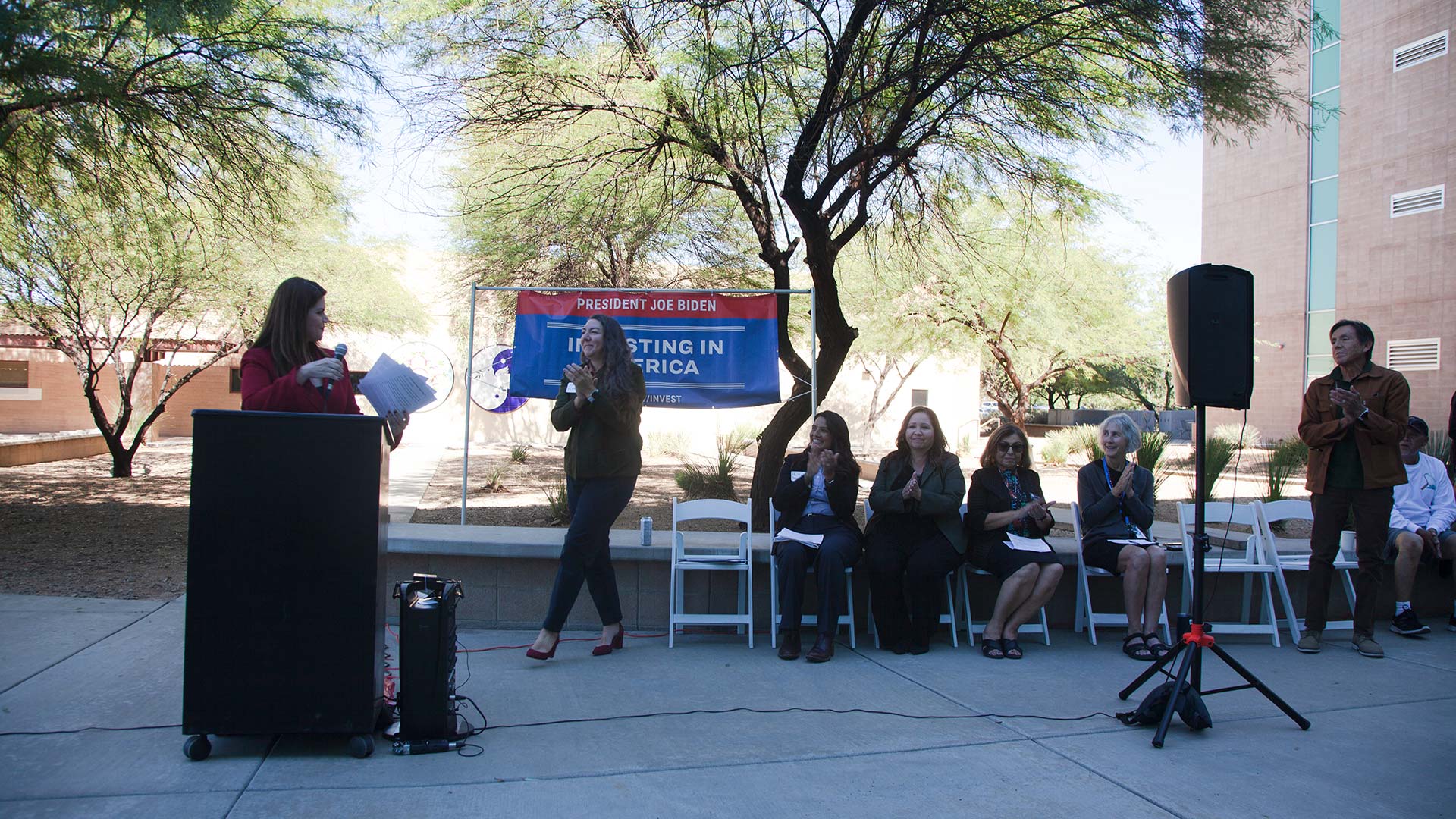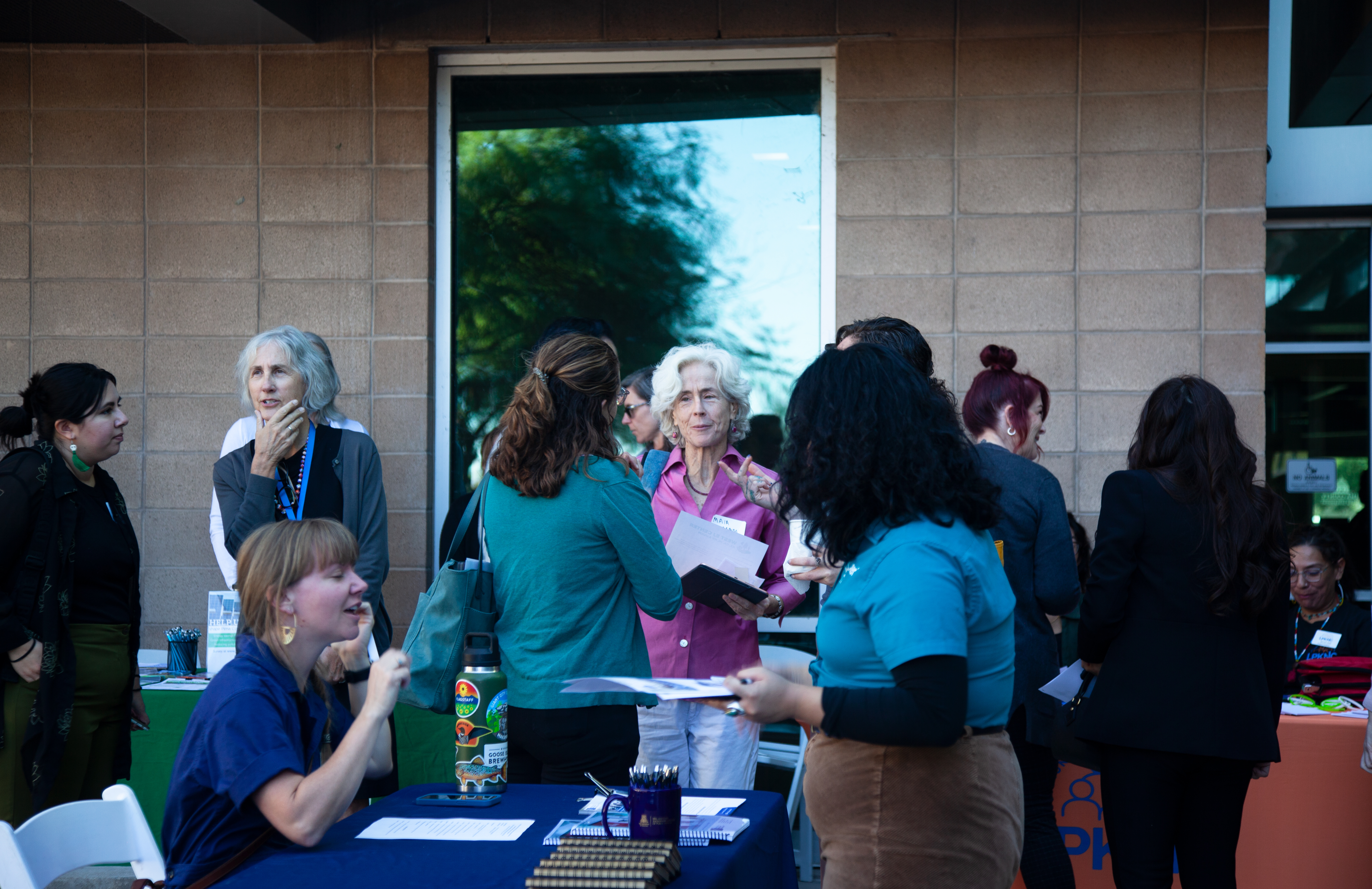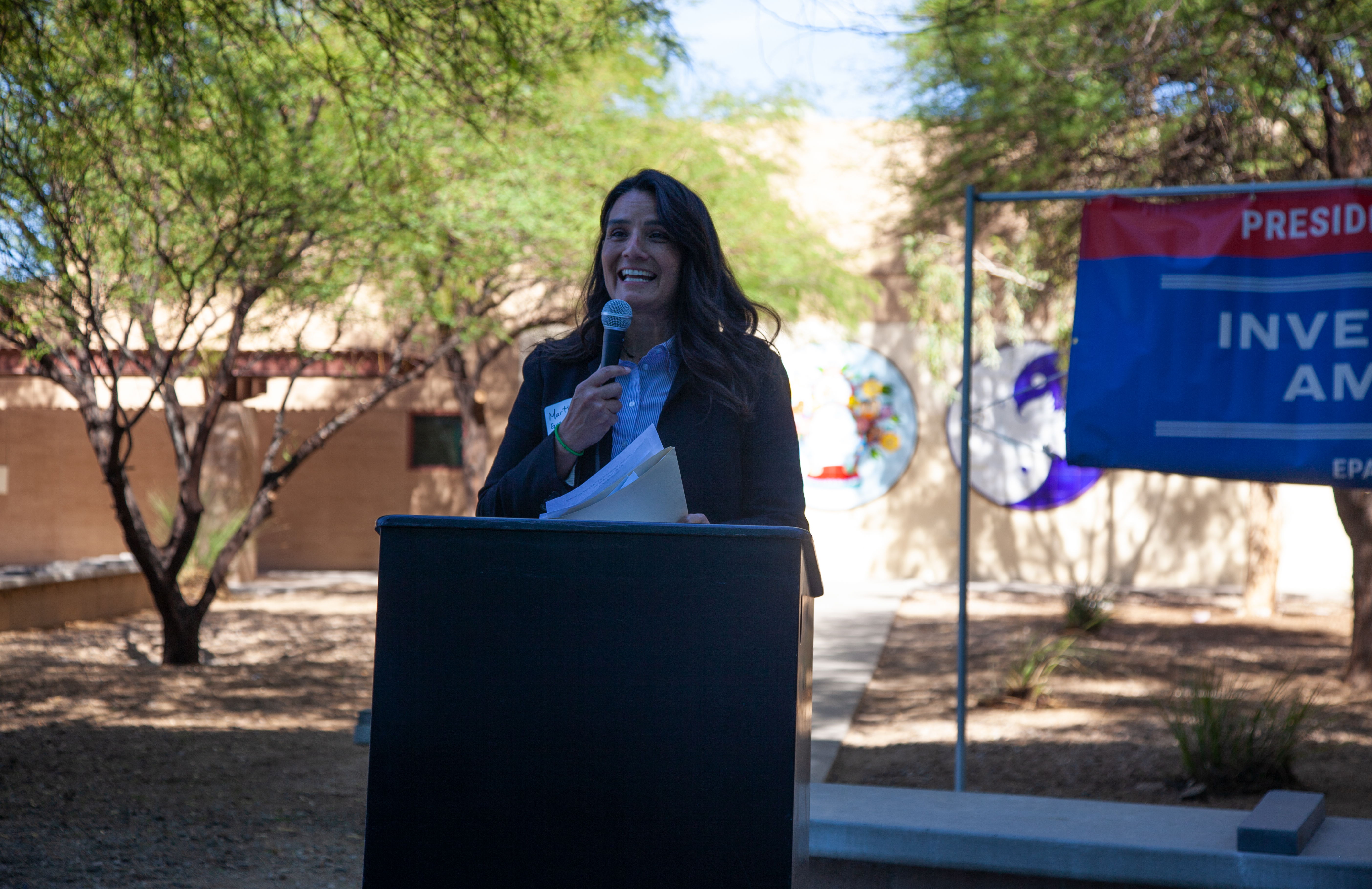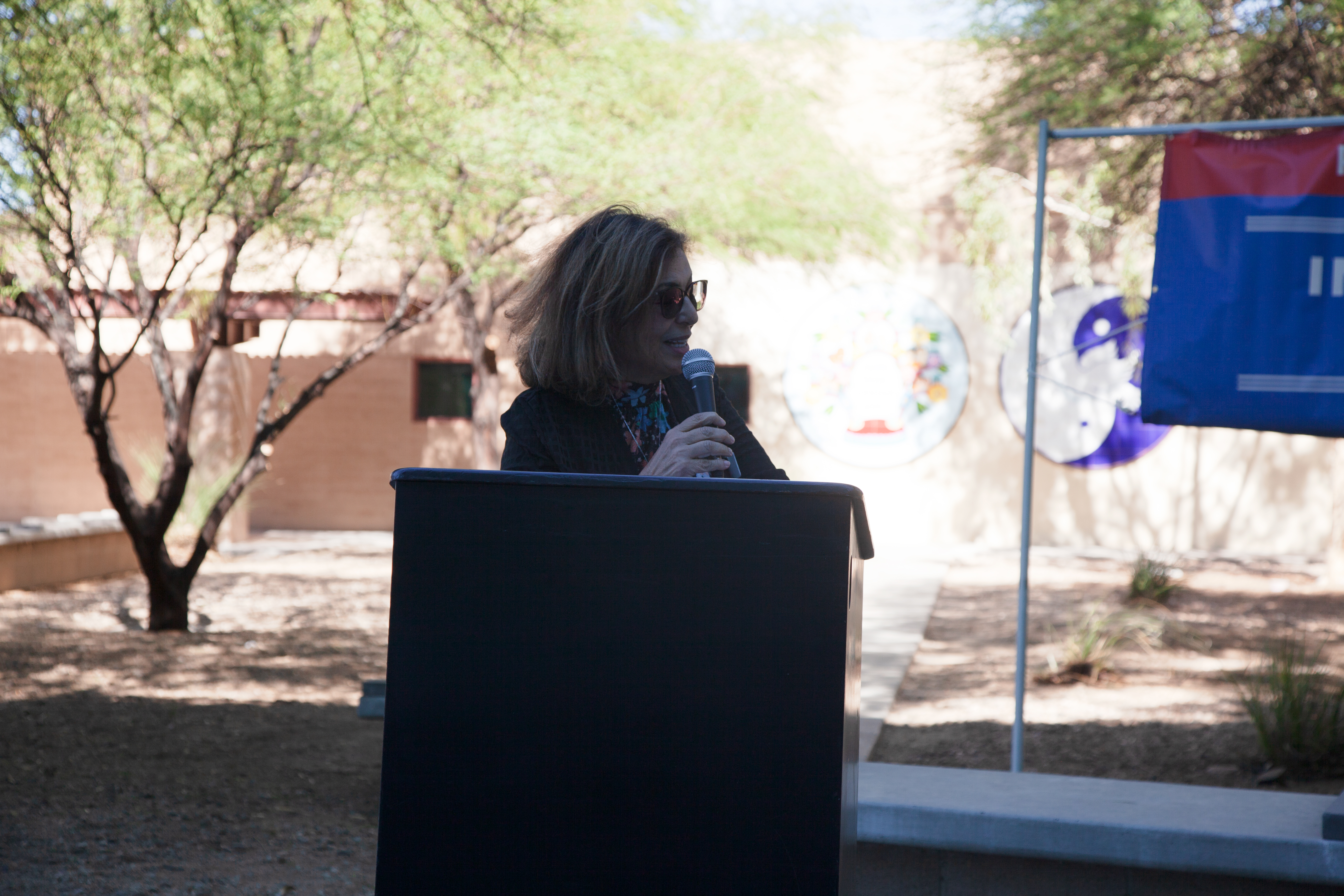 Regional and local leaders came to celebrate the kick off event for the new University of Arizona Western Environmental Science Technical Assistance Center for Environmental Justice (WEST EJC) at the Pima County Abrams Public Health Center in Tucson, Ariz., on Wednesday, Nov. 1.
Regional and local leaders came to celebrate the kick off event for the new University of Arizona Western Environmental Science Technical Assistance Center for Environmental Justice (WEST EJC) at the Pima County Abrams Public Health Center in Tucson, Ariz., on Wednesday, Nov. 1.From left to right: City of Tucson Mayor Regina Romero, EPA Regional Tribal Operations Committee Co-Chair Laura Ebbert, Regional Administrator for EPA Martha Guzman, Chair of the Pima County Board of Supervisors Adelita Grijalva, Dean of the Mel & Enid Zuckerman College of Public Health, Iman Hakim, Pima County Health Director Theresa Cullen, Deputy County Administrator, Francisco Garcia.
The University of Arizona will serve as a hub in the west for environmental justice, through its participation in the Environmental Protection Agency’s (EPA) Environmental Justice Thriving Communities Technical Assistance Centers Program (WEST EJC.)
Through collaborative partnerships throughout the region, the WEST EJC aims to enhance community engagement in decision-making processes related to environmental science, energy infrastructure, climate change and public health.
On Wednesday Nov. 1, local and regional leaders gathered at the Pima County Health Department Abrams Clinic, to celebrate the inauguration of this new center with a community kickoff and resource fair.
 VIEW LARGER Members of the community at the kickoff event for the University of Arizona Western Environmental Science Technical Assistance Center for Environmental Justice (WEST EJC) at the Pima County Abrams Public Health Center in Tucson, Ariz., on Wednesday, Nov. 1. The new center looks to provide communities with services and resources to improve accessibility in environmental and energy justice.
VIEW LARGER Members of the community at the kickoff event for the University of Arizona Western Environmental Science Technical Assistance Center for Environmental Justice (WEST EJC) at the Pima County Abrams Public Health Center in Tucson, Ariz., on Wednesday, Nov. 1. The new center looks to provide communities with services and resources to improve accessibility in environmental and energy justice. Earlier this year, the UA was selected as one of 16 environmental justice centers that will work to support underserved communities through a variety of community-centric initiatives such as federal grant writing, advocacy and translation services to improve accessibility for those with environmental justice concerns.
The establishment of these centers was made possible through a $177 million funding allocation through the Inflation Reduction Act, with cooperation from the EPA and Department of Energy (DOE).
The UA WEST EJC received a total of $10 million, which must be spent over the course of three years and serve not only Arizona, but also California, Nevada Hawai’i and U-S-Affiliated Pacific Islands.
It will also collaborate with fellow EPA Region 9 recipient, the San Diego State University Foundation.
 VIEW LARGER Regional Administrator for the Environmental Protection Agency (EPA), Martha Guzman at the Pima County Abrams Public Health Center in Tucson, Ariz., on Wednesday, Nov. 1. Guzman's visit came for the inaugural celebration of the new University of Arizona Western Environmental Science Technical Assistance Center for Environmental Justice (WEST EJC).
VIEW LARGER Regional Administrator for the Environmental Protection Agency (EPA), Martha Guzman at the Pima County Abrams Public Health Center in Tucson, Ariz., on Wednesday, Nov. 1. Guzman's visit came for the inaugural celebration of the new University of Arizona Western Environmental Science Technical Assistance Center for Environmental Justice (WEST EJC). Martha Guzman, EPA regional administrator, emphasized that the hub will function as a technical bridge, facilitating partnerships across the region and helping communities navigate the process of obtaining and sustaining funding and technology resources.
Guzman also underscored the federal government’s responsibility to institutionalize environmental justice.
“The whole data that we’re bringing forward in the science on environmental justice, is that race is a major indicator of pollution, it’s the highest correlation to contamination,” Guzman said.
She added that there is an opportunity to address the disparities in racial impact, not only through funding but also by using a regulatory framework to address disproportionality highlighted by data.
 VIEW LARGER Dean of the University of Arizona Mel & Enid Zuckerman College of Public Health, Dr. Iman Hakim at the Pima County Abrams Public Health Center in Tucson, Ariz., on Wednesday, Nov. 1. Hakim said a few words at the kick off event for the new University of Arizona Western Environmental Science Technical Assistance Center for Environmental Justice (WEST EJC).
VIEW LARGER Dean of the University of Arizona Mel & Enid Zuckerman College of Public Health, Dr. Iman Hakim at the Pima County Abrams Public Health Center in Tucson, Ariz., on Wednesday, Nov. 1. Hakim said a few words at the kick off event for the new University of Arizona Western Environmental Science Technical Assistance Center for Environmental Justice (WEST EJC). Dr. Iman Hakim, the Dean of the Mel and Enid Zuckerman College of Public Health said the initiative has built a capacity to bring resources and programs that will contribute to environmental equity for all.
“In public health, we are always working to create a more just and equitable world and environmental justice is foundational for our mission, Hakim said. “Here at the University of Arizona, our public health and environmental research are recognized as some of the nation’s finest.”
The partnership between the UA and WEST EJC program promises to make a meaningful impact on environmental equity and justice in the west, pledging to a more just and sustainable future.

By submitting your comments, you hereby give AZPM the right to post your comments and potentially use them in any other form of media operated by this institution.